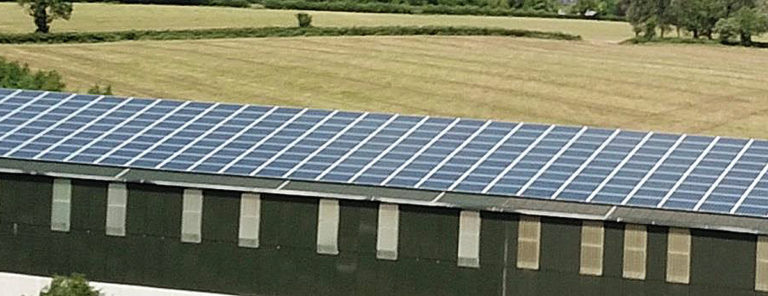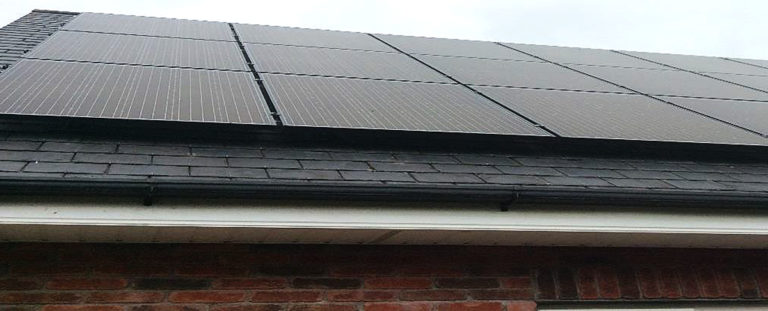The role of solar PV and energy storage in farming.

Solar photovoltaic (PV) is the process of converting energy from daylight into electricity and the brighter the day the more generation takes place.
The technology is well proven; electricity generation is accurately predictable and guaranteed and maintenance is very low.
Its costs have reduced by over 80% in the past 10 years through a combination of increased cell efficiency and lower manufacturing and raw material costs.
These facts – combined with the upward trend in electricity prices and a new 40% grant for farmers through TAMS and 100% accelerated capital allowances in year of purchase – makes a Solar PV install a really smart investment for farm families wishing to reduce their energy costs and carbon emissions.
Other opportunities for securing grants are available through the BEC programmes run by the SEAI. The ability to generate your own electricity is going to be even more valuable and important as planned Government increases in carbon taxes start to bite.
Solar PV makes the best economic sense when all of the electricity generated is used on the farm or in the home.
In addition, a Solar PV investment on a farm benefits from 100% written off against tax in the year of purchase and farmers can also reclaim the VAT element of the cost.
A Wise Investment?
Up to 70% of the investment cost for sole traders, and 50% for farm companies, is covered by a grant and tax write offs.
Also, farmers investing in Solar PV will reduce their bought-in electricity for decades to come and they will be seen as being pro-active in reducing carbon emissions which is a key message for a growing sector.
Funding A Renewable Investment On Farm
In Local Power Ltd, we design the system for farms to ensure all of the energy is used in the business for quickest payback.
In addition, Local Power Ltd provides a funding option for farmers that pays for the investment over a 5/7-year period from the energy savings secured on the farm.
Expected Generation
Today, Solar PV has become a major source of renewable energy across the world. Its deployment is doubling every year.
Solar PV now accounts for over 2% of the world’s electricity generation. It is expected to grow exponentially in the years ahead. The industry in Ireland is relatively small but that’s about to change.
Contrary to a mistaken belief, Solar PV electricity generation works very well under Irish conditions. The output from Solar PV is very predictable.
It varies from 800kwh to 1100kwh per year per KwP installed. This depends on the part of Ireland and on whether the panels are facing south or east/west.
It is not recommended to face panels north unless the roof space is almost flat. Solar panels also work well on flat roof spaces tilted south or east /west. The PV panels have self-clean glass and the Irish rainfall does the cleaning job automatically.
Full Transparency
Solar PV generation systems are remotely monitored and farmers will be able to see the energy generated hourly, daily, yearly etc.
It also has the added benefit of showing what they are buying from the grid. This allows the development of a clearer understanding of their energy usage which is a very positive thing.
Solar PV generates energy in a bell-shaped curve between January and December and is very much in line with the electricity demands on dairy farms for example. Not only that, but daily output will vary depending on the way the panels are facing.
Ideally, Solar PV systems should be sized so that the output generated at any time is less than the base load used on the farm.
For example, Appendix 1 shows a picture of a 100kwp system on a pig farm in the midlands that Local Power ltd installed last year. This will generate about 93,000kwh of daytime electricity per year. All of the energy will be used on the farm.

Appendix 2 on the other hand is a 5kwp solar PV system with battery storage in a dwelling house. This system got a €3,800 grant from the SEAI, now available for all homes built before 2010, and is expected to generate circa 60% of the home’s annual electricity requirements.

To ensure that this is used in the house, surplus electricity is firstly diverted to heat water by turning the immersion on automatically when surplus solar PV generation is available, with the balance going to batteries during the day which then discharge at night to meet the home’s electricity needs.
On most traditional family farms there is a base load of electricity usage of between 2kwh and 6kwh every hour with significant peaks in the morning and evening on dairy farms.
On pig, poultry and dairy farms where there are robots the base loads are higher and it is easier to size a solar PV system without the need for battery storage.
The key is to size the system so that all of the electricity is used on the home/farm. On conventional dairy farms it will be necessary to divert surplus electricity towards heating water, to ice bank tanks and/or to battery storage or another electric appliance or vehicle.
Choose Technology Wisely
Standard solar PV panels are 1.66mx1m, 280/320w per panel, are glass foil design (cells between a pane of glass and foil laminate underneath) and come with a 10-year product warranty and a 25-year performance warranty based on a maximum panel degradation of 0.7%/year (i.e. panels reduce their efficiency over time).
Most mass-produced panels are manufactured in Asia.
However, there are alternative European manufactured panels. An example is Solarwatt. This is the only panel on the market manufactured in Germany and comes with the cells sandwiched between two panes of hardened glass.
It comes with a 30-year performance and a 30-year product warranty based on a maximum annual degradation of 0.345%.
These panels are very robust and should always be used on sites where ammonia gasses or salt erosion might be an issue. On a value for money basis these panels also stack up as owners can expect a minimum of 35% extra production over the life of the system.
The panels also come with a five-year automatic all risks insurance cover.
Direct experience by Local Power Ltd in Northern Ireland where there is lots of Solar PV installed has shown a recorded 12% difference in annual generation between an Asian manufactured PV panel and Solarwatt glass glass panels after six years of installation. What will that be in 20 years?
Choice Of Battery Critical
In relation to battery storage, there are lots of brands and farmers/home owners need to ensure that they buy ones that have the highest safety and efficiency standards.
Again, the German manufactured Solarwatt brand scores highest in this regard but are more expensive than the standard battery systems available.
Batteries can also operate AC or DC and these are known as hybrid. What that means is that the battery can be charged DC by surplus solar during the day and once discharged can be recharged on cheaper night rate electricity for discharge in the morning when electricity costs more.
Batteries can also act as a power back up in case of outage assuming of course that the battery is charged when the outage occurs.
However, buyer beware. Hybrid Battery systems can lose as much as 40% efficiency in the process of converting between AC and DC and also significantly reduce the life of the battery cells by so doing.
What that means is this: Let’s say you buy a 4.8kwh hybrid battery system which in almost all cases has a charge to discharge of a maximum of 90%.
It charges DC from the solar PV during the day and discharges 80/90% equivalent of that in the evening.
Then, it recharges using AC night rate electricity and in the process of switching between AC and DC loses up to 40%.
In this case, the benefits of storing night rate electricity are almost totally lost. Also, another key point with battery storage is the speed of response.
Let’s say you turn a kettle on. You would expect the battery to immediately discharge to supply the energy and also to immediately stop discharging once the kettle is turned off.
Many battery systems take as many seconds to both discharge and then to stop discharging which can also lead to significant losses in efficiency.
Therefore, the message is to buy a battery system that has the proven pedigree and does the job of storing DC energy from your Solar PV efficiently.
If you want to store night rate electricity then a dedicated AC solution should be installed; but again, ask the questions on efficiency. Buying the wrong battery system costs dearly in efficiency and longevity.
Reducing Carbon Emissions
For every 10kwp of solar PV that is installed on a farm approximately 5t of carbon will be displaced per year. Solar PV will be a very visual sustainability initiative on farms.
From our work to date with farmers they are very interested and keen to invest in this technology. The low maintenance and predicable output are key advantages of Solar PV over and above micro wind which from experience on farms has high maintenance and very unpredictable generation patterns.
Electricity Export Potential From Solar PV On Farm Roofs Etc.
There may be an option for putting Solar PV on the roof spaces of farm buildings in the future depending on what supports, if any, the Government provides.
Particularly for community-type projects which they say they are going to incentivise and support. We will have a more exact understanding of what the Government are proposing in the next few months and we will be lobbying through the Micro Renewable Energy Federation (MREF) to secure a viable option for using farm roof tops for exporting to the grid.
So far, a total of 6GW of farm solar PV (30,000 acres) is proposed to be developed across the country and mainly in the east and south of the country.
How much of this that will eventually be built depends on many variables including access to grid, grid cost, planning permission, build cost, location scale and so on. For most farmers the risks are very high and solar farms tend to be promoted by specialist developers.
Large scale Solar PV, like large scale wind etc, will be supported through the new RESS, renewable energy support scheme. The full document in relation to RESS can be accessed here: www.dccae.ie
In summary, all projects with planning and grid connections will be able to bid to provide energy through an auction process.
The first auction, scheduled for late 2019, is technology neutral and will be for 1000 GW/h which will be filled with 356MW on shore wind, 253MW off shore wind, 1,000MW solar or 134MW of biomass.
The second auction in 2020/2021 is for 3,000GW/hrs. There will be other auctions for 3,000GW/hrs in 2021, 2023 and 2025.
Significantly, bid bonds will be required for those participating in the auction process which is aimed at stopping speculation.
Any project hoping to secure support must have planning and grid connection. There is an opportunity for farmers to participate in community renewable projects and the key is to ensure that Government policy being developed currently supports farmer involvement in community projects
Currently, there is circa 3,500MW of renewable energy generation in Ireland and in the National Development Plan Ireland will need to deliver an additional 4,500MW (onshore wind equivalent) of renewable energy generation by 2030.
To date, relating to the 2020 targets, Ireland has delivered 27% of its 40% target in electricity, 5% of its 10% in transport and 6.8% of its 12% target in heat, so there’s lots of potential for the sector going forward if these targets are to be met.
More Information
For more information call: (01) 825 0263 or 086 261 3374, or just click here
April 2019
Agriland




